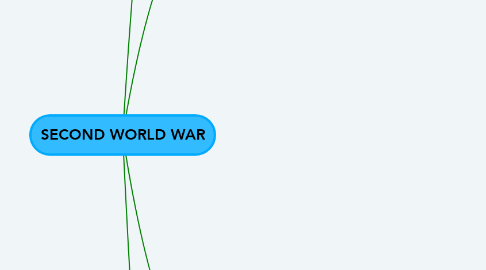
1. First phase: Axis offensives in Europe, Africa and Asia (1936-1942)
1.1. In Europe, Germany won various victories due to its strategy.
1.1.1. 1940: German forces occupied Denmark and Norway (north) and Netherlands, Belgium, Luxembourg and France (west)
1.1.2. 1941: Hitler ordered the invasion of the USSR, this attacked broke the non-aggression pact that Germany had signed with the USSR.
1.1.3. Stalin responded by joining the Allies, the soviet forces adopted a scorched earth policy but the German forces advanced rapidly and reached the outskirts of Moscow, winter arrived and forced them to come to halt.
1.2. In Africa:
1.2.1. In 1940 the Italians attacked the British protectorate of Egypt from Libya.
1.2.2. They were helped by the German army, the Afrika Krops, led by Field Marshall Rommel.
1.2.3. Their objective was to gain control of the Suez Canal in order to control the Mediterranean.
1.3. In Asia and the Pacific:
1.3.1. In 1941 the Japanese invaded the French colonies in Indochina and began their expansion in the Pacific.
1.3.2. The United States (with colonies in Indochina and Hawaii) announced an embargo on steel and petroleum exports to Japan in an attempt to stop expansion.
1.3.3. Japan responded with a surprise attack on the American naval base at Pearl Harbor, Hawaii.
1.3.4. As a result, the United States declared war on Japan and joined the war on the side of the Allies.
2. Third phase: final Allied advances in Asia and the Pacific (1942-1945)
2.1. In Asia and the Pacific, the effectiveness of aicraft carriers and American submarines put an end to the Japonese control of the Pacific islands.
2.1.1. The Battle of the Coral Sea and the Battle of Midway (1942), the Japanese were defeated and they lost control of some of the Pacific islands. Allied advances in the Pacific were consolidated.
2.1.2. In 1944, the naval Battle of the Philippine Sea took place when the Americans triunphed.
2.1.3. However, their sacrifice was not enough to stop the troops and the Americans defeated them again.
2.1.4. As a result, Japan finally surrendered on 2 September 1945, amd the Second World War ended.
2.1.5. At the Battles of Iwo Jima and Okinawa (1945), the Japanese used Kamikaze pilots to stop Allied troops reaching Japan.
3. Allied advances in Europe (1942-1945)
3.1. In southern Europe, the Germans conquered Greece and Crete, the Axis was joined by Hungary, Romania, Slovakia and Bulgaria which allowed them to go through the USSR.
3.2. Allied troops invaded most of the Italian peninsula, as a result, Mussolini was dismissed (1943) and then executed in 1945.
3.3. In Europe, the following battles and events signalled the end of the war in favour of the Allies.
3.3.1. The Battle of the Atlantic (1942-1943) : the Germans intesified their naval war with a large-scale of submarines to stop supplies reaching the Allied forces and isolate Great Britain.
3.3.2. The Battle of Stalingrad (1942-1943): German forces occupied the city but the Soviet army counter-attacked and surrounded the German forces for months.
3.3.3. The Germans were forced to surrender and began to retreat from the USSR.
3.3.4. The Conference of Tehran (1943): the representatives of the Great Britain, the United States and the USSR agreed to open a new front in France with the aim of liberating Western Europe.
3.3.5. Following a difficult battle against the Germans, they finally managed to force them to retreat as far as Paris.
3.3.6. September 1944: after France was liberated, the Allies advanced towards Germany from three fronts: France, the USSR and the north of Italy.
3.3.7. The Soviets liberated Poland, Hungary and Czechoslovakia.
3.3.8. In May 1945, Allied troops entered Berlin; Hitler committed suicide to avoid being captured.
3.3.9. On May 1945, Germany surrendered.
3.3.10. The Normandy Landins (6 June 1944): the Allied troops, under the command of the American General Eisenhower, landed on the cost of Normandy in France.
3.3.11. To put an end to the conflict (1945), the United States President Harry Truman authorised the droppin of atomic bombs in the cities of Hiroshima and Nagasaki.
